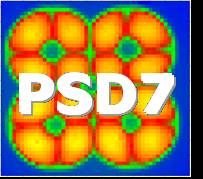Speaker
Mr
Noriaka Tawa
(Osaka University)
Description
We developed a new photon-counting device for
X-ray in the 0.1-100 keV energy range. The new
device is an X-ray charge-coupled device (CCD) on
which scintillator is directly deposited. It is called
a scintillator-deposited CCD (SD-CCD). Low energy
X-rays (0.1-10 keV) can be directly detected by
the CCD while high energy X-rays (10-100 keV) pass
through it into the scintillator where they generate
hundreds or thousands of visible light photons. Their
number is proportional to the incident X-ray energy.
These photons can be detected by the CCD, a fact
that enables it to effectively detect X-rays in the 0.1-
100 keV energy range.
In order to achieve a high energy resolution, it is important that
the number of visible
light photons detected by the CCD increase. There are two types of
CCD: a front-illuminated
(FI) CCD and a backside-illuminated (BI) CCD. The BI CCD has higher
sensitivity at low
energy as well as visible light photons than the FI CCD, so we
employed the BI CCD. As
scintillator, we selected CsI(Tl). CsI(Tl) possesses the highest
light yield among scintillators,
and the light yield is above 60 photons/keV at -60oC. The emission
spectrum of CsI(Tl)
ranges between 350 and 700nm with a maximum at 550 nm. The detection
efficiency of
the FI CCD is of 20% while the BI CCD is of 85% at 550 nm. We
fabricated two types of
SD-CCD. One is coupled CsI(Tl) to the front side of the BI CCD with
an optical cement,
and the other one is directly deposited CsI(Tl) to the front side of
the BI CCD. We suppose
that depositing SD-CCD is less photons loss between CsI(Tl) and CCD
than coupling SDCCD.
But the coupling SD-CCD is higher energy resolution than the
depositing SD-CCD.
The FWHM energy resolution at 59.5 keV of the coupling SD-CCD is
(26±1% whereas the
depositing SD-CCD is (38±3)%.
In order to optimize the structure of SD-CCD, we employed the Monte-
Carlo simulation
software, DETECT2000. Since the CsI(Tl) crystals of the SD-CCDs were
needlelike structure,
it prevents the lateral spread of visible light photons. We
simulated light transport in
the needlelike CsI(Tl) and the non-needlelike CsI(Tl). In the
needlelike CsI(Tl), the spread
of visible light photons on the CCD is 60 μm at FWHM while it is
270 μm in the nonneedlelike
CsI(Tl). Therefore, the number of photons detected in one pixel (24x24 μm2) of
the SD-CCD employing non-needlelike CsI(Tl) is about half that of
the SD-CCD employing
needlelike CsI(Tl). This simulation is consistent with experimental
result obtained with
SD-CCD.
Primary author
Mr
Noriaka Tawa
(Osaka University)




